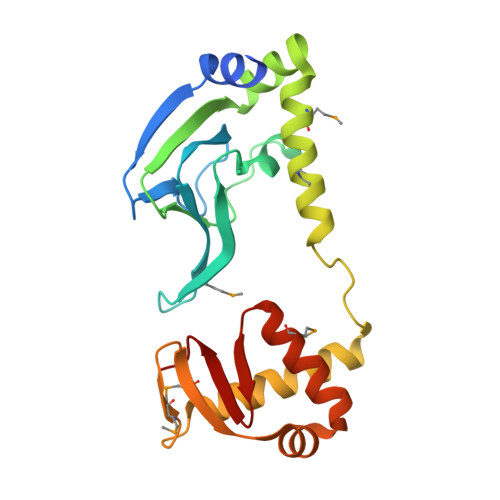Structures of inactive CRP species reveal the atomic details of the allosteric transition that discriminates cyclic nucleotide second messengers.
Seok, S.H., Im, H., Won, H.S., Seo, M.D., Lee, Y.S., Yoon, H.J., Cha, M.J., Park, J.Y., Lee, B.J.(2014) Acta Crystallogr D Biol Crystallogr 70: 1726-1742
- PubMed: 24914983
- DOI: https://doi.org/10.1107/S139900471400724X
- Primary Citation of Related Structures:
4N9H, 4N9I - PubMed Abstract:
The prokaryotic global transcription factor CRP has been considered to be an ideal model for in-depth study of both the allostery of the protein and the differential utilization of the homologous cyclic nucleotide second messengers cAMP and cGMP. Here, atomic details from the crystal structures of two inactive CRP species, an apo form and a cGMP-bound form, in comparison with a known active conformation, the cAMP-CRP complex, provide macroscopic and microscopic insights into CRP allostery, which is coupled to specific discrimination between the two effectors. The cAMP-induced conformational transition, including dynamic fluctuations, can be driven by the fundamental folding forces that cause water-soluble globular proteins to construct an optimized hydrophobic core, including secondary-structure formation. The observed conformational asymmetries underlie a negative cooperativity in the sequential binding of cyclic nucleotides and a stepwise manner of binding with discrimination between the effector molecules. Additionally, the finding that cGMP, which is specifically recognized in a syn conformation, induces an inhibitory conformational change, rather than a null effect, on CRP supports the intriguing possibility that cGMP signalling could be widely utilized in prokaryotes, including in aggressive inhibition of CRP-like proteins.
Organizational Affiliation:
Research Institute of Pharmaceutical Sciences, College of Pharmacy, Seoul National University, Seoul 151-742, Republic of Korea.















